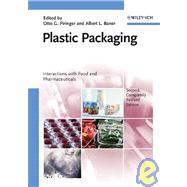
Plastic Packaging Interactions with Food and Pharmaceuticals
by Piringer, Otto G.; Baner, A. L.Buy New
Rent Textbook
Used Textbook
We're Sorry
Sold Out
eTextbook
We're Sorry
Not Available
How Marketplace Works:
- This item is offered by an independent seller and not shipped from our warehouse
- Item details like edition and cover design may differ from our description; see seller's comments before ordering.
- Sellers much confirm and ship within two business days; otherwise, the order will be cancelled and refunded.
- Marketplace purchases cannot be returned to eCampus.com. Contact the seller directly for inquiries; if no response within two days, contact customer service.
- Additional shipping costs apply to Marketplace purchases. Review shipping costs at checkout.
Summary
Author Biography
Dr. Baner, who has degrees in food science, packaging and agricultural engineering, has been researching and working in the packaging field since 1981. He has worked at Michigan State University, the Fraunhofer Institute of Food Technology and Packaging in Munich, the Nestle Research Center in Lausanne and is currently a research packaging scientist with Nestle Purina Petcare in Saint Louis. His research areas encompass the experimental determination and estimation of permeation, diffusion, sorption and migration of flavor molecules and packaging constituents between packaged goods and their packaging. Albert Lawrence Baner is author and co-author of more than 30 scientific papers.
Table of Contents
| Preface | |
| List of Contributors | |
| Preservation of Quality Through Packaging | |
| Quality and Shelf-Life | |
| Physical and Chemical Interactions Between Plastics and Food or Pharmaceuticals | |
| The Organization of this Book | |
| Characteristics of Plastic Materials | |
| Classification, Manufacture, and Processing Aids | |
| Structure and States of Aggregation in Polymers | |
| The Most Important Plastics | |
| Polymer Additives | |
| Introduction | |
| Antifogging Agents | |
| Antistatic Agents | |
| Blowing Agents | |
| Colorants | |
| Fillers and Reinforcing Agents | |
| Lubricants | |
| Nucleating Agents | |
| Optical Brighteners | |
| Plasticizers | |
| Stabilizers | |
| Transformation Products of Plastic Stabilizers | |
| Conclusions | |
| Partition Coefficients | |
| Experimental Determination of Polymer Liquid Partition Coefficients | |
| Thermodynamics of Partition Coefficients | |
| Estimation of Partition Coefficients Between Polymers and Liquids | |
| Models for Diffusion in Polymers | |
| Diffusion in Polymers - The Classical Approach | |
| Diffusion in Polymers - The Computational Approach | |
| Conclusions | |
| A Uniform Model for Prediction of Diffusion Coefficients with Emphasis on Plastic Materials | |
| Introduction | |
| Interaction Model | |
| Prerequisites for Diffusion Coefficients | |
| The Diffusion Coefficient | |
| Transport Equations and Their Solutions | |
| The Transport Equations | |
| Solutions of the Diffusion Equation | |
| Numerical Solutions of the Diffusion Equation | |
| Solution of the Diffusion Equation for Multilayer Packaging | |
| Introduction | |
| Methods for Solving the Diffusion Problem in a Multilayer (ML) Packaging | |
| Solving the Diffusion Equation for a Multilayer Packaging in Contact with a Foodstuff | |
| Development of a User-Friendly Software for the Estimation of Migration from Multilayer Packaging | |
| User-Friendly Software for Migration Estimations | |
| Introduction | |
| MIGRATEST#Lite - A User-Friendly Software for Migration Estimations | |
| Permeation of Gases and Condensable Substances Through Monolayer and Multilayer Structures | |
| Introduction: Barrier Function of Polymer-Based Packaging | |
| Permeation Through Polymeric Materials | |
| Substance Transport Through Single and Multilayer Polymer Substrates Combined with One Inorganic Barrier Layer | |
| Substance Transport Through Polymers Filled with Particles | |
| Experimental Findings: Polymer Films and One Inorganic Barrier Layer | |
| Experimental Findings: Combinations of Polymer Films and More Than One Inorganic Barrier Layer | |
| Experimental Findings: Polymers Filled with Platelet-Shaped Particles | |
| Experimental Findings: Permeation of Flavors Through Mono- and Multilayer Films and Combinations with Inorganic Barrier Layers | |
| Conclusions | |
| Migrat | |
| Table of Contents provided by Publisher. All Rights Reserved. |
An electronic version of this book is available through VitalSource.
This book is viewable on PC, Mac, iPhone, iPad, iPod Touch, and most smartphones.
By purchasing, you will be able to view this book online, as well as download it, for the chosen number of days.
Digital License
You are licensing a digital product for a set duration. Durations are set forth in the product description, with "Lifetime" typically meaning five (5) years of online access and permanent download to a supported device. All licenses are non-transferable.
More details can be found here.
A downloadable version of this book is available through the eCampus Reader or compatible Adobe readers.
Applications are available on iOS, Android, PC, Mac, and Windows Mobile platforms.
Please view the compatibility matrix prior to purchase.
